Molly Fish Complete Care Guide To Keep In An Aquarium
This post may contain affiliate links.
Mollies are a staple of the fishkeeping hobby. They come in a plethora of colors and are of different varieties. As popular as these fish are, there is a lot of conflicting information about how to keep them, which may create confusion among new owners. However, you don’t have to worry a bit because you have found your way to this webpage.
The following sections contain everything you should know about maintaining a thriving Molly aquarium. It includes a brief overview of the fish, tank setup, feeding guide, breeding tips, and introduction to common diseases and disorders associated with Molly fish. We have addressed all that here and much more.
An In-depth Look At Molly Fish – Types, Size & Lifespan

Molly fish is a member of the genus Poecilia. They’re found in the Southern United States, Central America, and from Mexico to Columbia.
They are often said to be brackish fish. However, in nature, Mollies inhabit freshwater streams, coastal brackish, and even marine waters.
Types of Molly Fish
Mollies are of several varieties and have a plethora of colorings, presenting a wide range to choose from.
They come in black, gold, white, orange, red, green, blue, marble, platinum, and Dalmatian (white with black spots). You can find Mollies based on different fin styles, such as common fin, lyretail, sailfin, and ballon.
Following is a list of the most popular Mollies you can start with.
- Short-finned Molly
- Sailfin Molly
- Balloon Belly Molly
- Yucatan Molly
- Dwarf Molly
- Liberty Molly
- Black Molly
- Silver Molly
- Dalmatian Molly
- Gold Dust Molly
- Marble Molly
- Lyretail Molly
NOTE: Most Mollies sold in LFS are hybrids created by cross-breeding of two or more species. Sometimes, it can be challenging to determine what type you are getting.
Average Size
How big a Molly can get depends on its type. They usually average around 3 to 4 inches when given an ideal habitat and adequate nutrition.
Interestingly, some species can get as large as 6 inches. Besides water quality and food, genetics plays a major role in their growth.
In comparison, female Mollies are usually bigger than males.
Temperament
The consensus is that Mollies are peaceful fish, but it depends on what you keep them with and how you keep them.
If you keep Molly fish individually in a community tank, it can get a bit aggressive and fin-nippy. However, in a large community of Mollies, they are relatively peaceful. It’s all about the right environment.
Lifespan
In a perfect environment (devoid of stressors), Molly fish can live up to 5 years.
Molly Fish Aquarium Setup
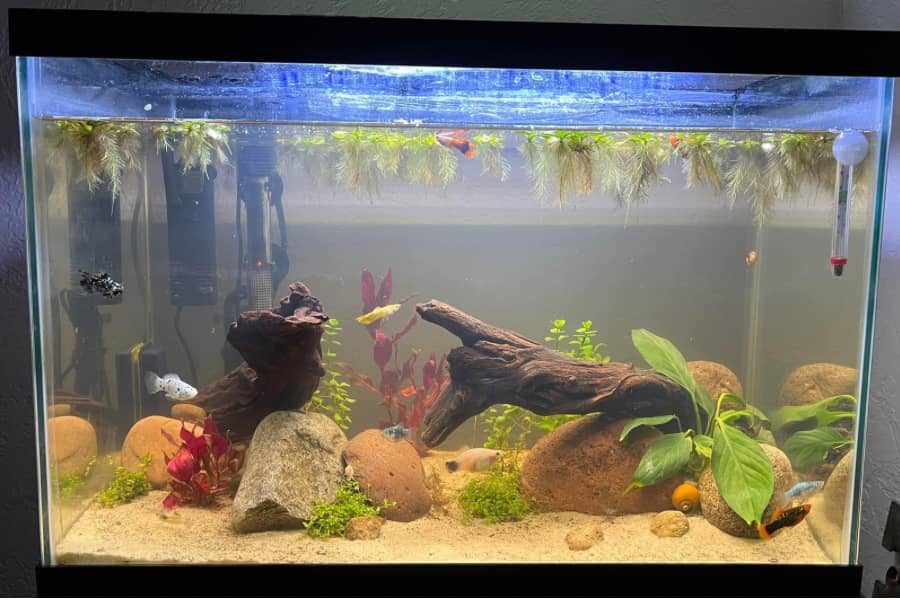
To set up an ideal Molly habitat, consider the suggestions given below.
Recommended Tank Size
You don’t want to keep Mollies in anything less than 29 gallons. Preferably, if you can do 50 gallons, your fish will thrive in it.
When it comes to Mollies, know that these fish require pristine quality water. Even a slight trace of toxins or less-than-perfect water conditions will cause stress and bring forth various diseases.
It always pays off to have a larger aquarium – it reduces the frequency of water changes and is less prone to biological and chemical fluctuations, which keeps the water parameters stable and toxins diluted.
Ideal Water Parameters
Temperature: Mollies prefer the temperature on the warmer side. Ideally, keep it between 76°F – 82°F (24°C – 28°C)
pH Levels: Mollies can live in a wide pH range. Generally, they do well as long as you are on the alkaline side of the pH scale, so keep it above 7.5 and under 8.5.
Water Hardness: Mollies like hard water. Aim to maintain the GH (General Hardness) at 10° to 25° dH. KH (Carbonate Hardness) should also be moderately high for a stable pH.
- The easiest way to increase water hardness (mineral content) in aquariums is by using crushed coral or oyster shells in your filter or as a substrate.
Toxin-free Water: Mollies are more sensitive to toxins than other fish. They need exceptionally clean water. And when not given the habitat of their liking, the fish will quickly succumb to various sorts of diseases and will eventually lose their life.
- Ammonia and nitrite should always be at 0 ppm or at least no more than .25 ppm. Nitrates preferably under 20 ppm.
- A good filtration system (capable of handling your tank’s bioload) combined with partial water changes will help you achieve optimal water conditions.
Do Molly Fish Need Salt In Water?
The great “Molly-salt debate” has always been a point of confusion among livebearer fishkeepers. Due to the lack of conclusive proof, two theories have come into existence.
One emphasizes the necessity of adding salt to Molly’s tanks, whereas the other theory simply begs to differ. Which one you should rely on?
According to Molly keepers, collectors, and livebearer experts, Molly fish don’t require additional salt. And here’s why:
Mollies that are being sold in stores are all hybrids of varying species. They are not the pure/true ‘brackish’ livebearers. The use of salt is mainly for medicinal purposes. Technically, salt in a tank enables hobbyists to get away with poor tank management practices, particularly overcrowding and infrequent water changes.
The bottom is: if you are on top of your water changes, keeping the toxins almost non-existent, and the water is hard (contains a high concentration of minerals) and well-aerated, your Mollies will do fine without the salt.
Necessary Equipment & Decor
The essential accessories for a Molly aquarium include:
- A water filter to keep the water clean, remove debris, and control toxin levels.
- Airstones to maintain high levels of oxygenation in the water.
- An aquarium heater to keep the tank warm.
- For decor, you can keep live plants, driftwood, and sand mixed with some pebbles or rocks as substrate.
Compatible Tank Mates
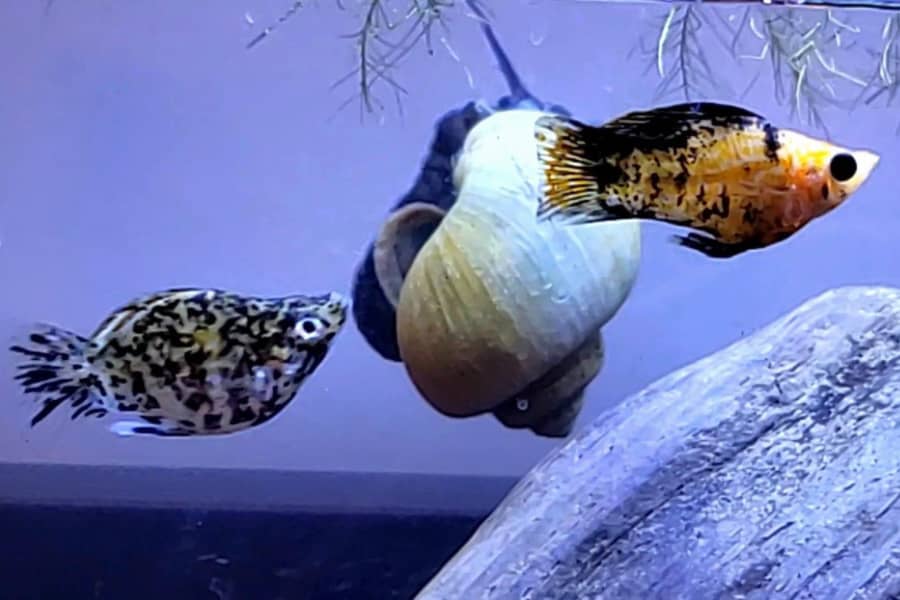
Consider the following factors when choosing tank mates for Molly fish:
- You need fish that can survive a more alkaline environment (higher pH) and slightly harder water to share a tank with Mollies.
- As previously mentioned, Mollies can be semi-aggressive depending on their environment. So, if you are keeping a small group of Mollies, avoid slow-moving, docile or long-finned fish.
- Peaceful, community fish that are close in size to Mollies and can live in similar environmental conditions, make the ideal tank mates.
While there are numerous options, based on our best experience, we suggest you go with these:
- Tetras (Emperor and Neon)
- Rasboras (Brilliant Green and Pork Chop)
- Roseline Shark
- White Cloud Mountain Minnow
- Bristlenose Pleco
- Cory Cats
- Danios
- Pencil Fish
- Loaches
- Barbs
- If you’re looking for Gouramis, go for less aggressive ones like Honey Gourami or Dwarf Gourami.
How Many Mollies Should Be Kept Together?
To avoid aggression, it’s best to keep at least 5 Mollies together in a ratio of 2-3 females to every male.
Things To Keep In Mind When Picking Mollies From Fish Store
Be extremely careful when picking up Mollies from a pet store.
Avoid fish that have clamped fins or are doing ‘Shimmies’ – shivering or shaking. Generally, these fish are not healthy and might have some health disorders.
Now, even if your Mollies look completely healthy and have no apparent signs of diseases or sickness, a quarantine period is a must. It is a precautionary measure to ensure you don’t accidentally end up spreading contagious diseases (like Ich or Columnaris) to your main tank.
What Does a Molly Fish Eat?
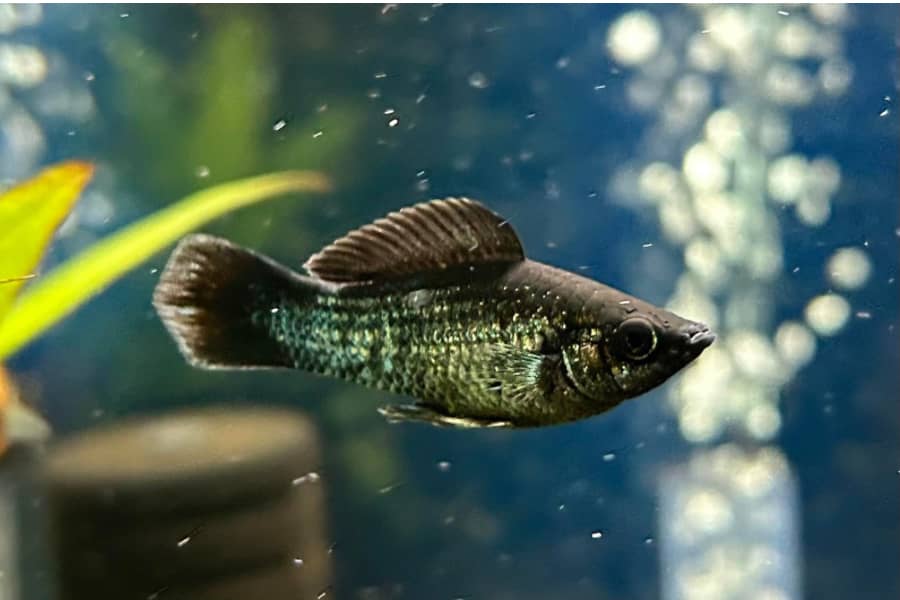
Mollies are omnivores. They require a diet with a good mix of meaty protein and plant matter to support optimal growth and good health.
The best part is that mollies aren’t finicky eaters and will always devour anything you offer them. The best food choices for these fish include high-quality flakes, pellets, baby brine shrimp, frozen bloodworms, and Repashy Soilent Green.
Never put your fish on just one type of food, such as feeding only frozen bloodworms. A varied diet ensures the fish gets all the essential micronutrients they may require. For Mollies, high-fiber food is particularly beneficial.
Keep in mind that mollies are beggars. No matter how much food you keep dropping in the aquarium, they never seem to be satiated. And this puts you at the risk of overfeeding.
As a basic rule, you can feed Mollies twice a day, with enough food, they can finish in 3 minutes. To promote better health and longevity, put your fish on a one-day weekly fast. It’s healthier for these aquatic beings.
NOTE: If your mollies have slightly swollen bellies and are often seen with long strings of normal-colored feces hanging from their bodies, you may be overfeeding them and need to cut back on the portion size.
Molly Fish Breeding Guide
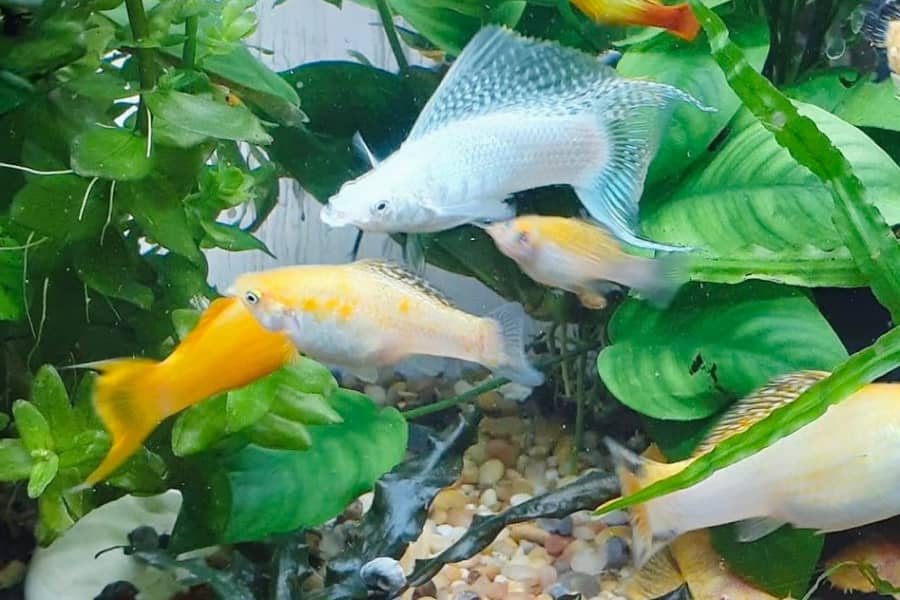
Breeding Mollies is as easy as adding a pair to a tank and waiting for them to multiply.
For that, first, you need to be able to distinguish a male molly from a female molly. A male can be easily identified by a stick-shaped anal fin (known as gonopodium), whereas a female has a fan-shaped (triangle) anal fin.
Size is another distinguishable factor, as female Mollies are slightly larger than males. In coloration, there is not much difference between the two genders. However, male fish may exhibit considerably more color depending on the species (such as sailfin mollies).
Having the appropriate water parameters is of utmost importance. The water should be clean, hard, and have a higher pH. Warmer temperatures are favorable for breeding, ranging from 80-82 degrees Fahrenheit.
Once you add a Molly pair to a breeding tank, the female may take around 30 to 60 days to give birth to young ones. For a new fish, the first batch is almost always small (as few as 5 frys), but a veteran mom can produce 50 or more babies (as many as 100) at a time.
NOTE: Remember to cover your filter’s intake tube to prevent the tiny fry from getting sucked in.
Do Mollies Eat Their Babies?
It’s not uncommon for Mollies to predate their young ones. However, if you keep the parents well-fed and provide fries with lots of bushy aquarium plants for hiding, they will have a higher survival rate.
The best choices include fluffy, maze-like plants like java moss, hornwort, water sprite, water wisteria, and Pogostemon Stellatus “Octopus.”
What To Feed Molly Fry?
Fries can be fed baby brine shrimp, crushed flake food, Repashy gel food, and everything else you feed to the parents (but smaller/crushed). For optimal growth, feed smaller meals several times a day.
A Molly fry usually takes 4 to 9 months to reach juvenile size. Temperature plays an important role in their growth rate and metabolism. Ideally, keep it between 74 to 78 degrees Fahrenheit.
Molly Fish Shaking – The Truth About ‘Death Shimmies’
Shimmying or Shimmies is a poor health condition commonly seen in Mollies and other livebearers where the fish does the snake-like slithering movement. It appears as if the fish is quivering or wiggling rapidly in place.
Also known as ‘Molly disease’, Shimmying is not a disease but a symptom indicative of poor water quality. While some people suggest low pH as a probable cause, in most cases, the lack of water hardness is a leading causative factor for Shimmies in Mollies.
Mollies prefer hard water, meaning they need sufficient calcium and magnesium ions in their water to function optimally. Test your water for GH (general hardness) to find out where the hardness levels lie.
If the test reading measures the GH to be lower than the recommended range (10° to 25° dH), add Wondershell to your tank to raise the water hardness naturally. Additionally, carry out water changes. They provide temporary relief by replenishing trace minerals.
Also, make sure the pH is between 7.5 to 8.5 and temperature is maintained at 76° – 80°F.
Treating Shimmies is simply getting rid of the underlying cause, which is usually soft water. Besides optimal water parameters, salt baths is often proposed as a remedy for curing Shimmying in Mollies.
Pregnant Molly Shaking
It’s not uncommon for pregnant Mollies to shake or vibrate right before giving birth. It’s a natural thing for a fish to do during the birthing period and is not the same as Shimmying.
Molly Fish Sitting At The Bottom of the Tank – Is It Alarming?
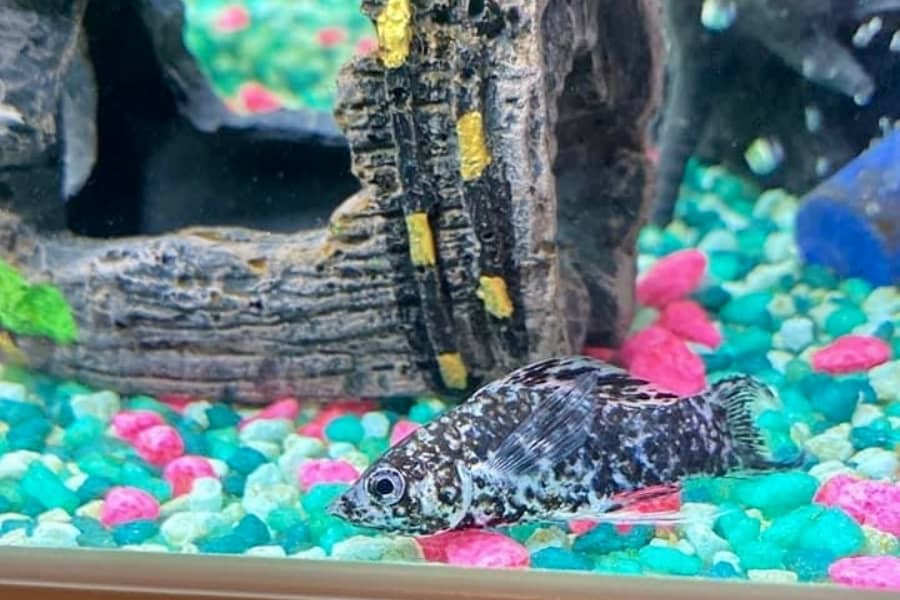
When a fish is ill or experiencing stress, usually it will sink and lie at the bottom of the tank for extended periods. Multiple factors can cause stress to fish, including:
- Poor water quality
- Uncycled aquarium
- Unsuitable temperature
- Inadequate tank size
- Aggressive tank mates
- Bacterial, fungal, or parasitic infection
- Aloneness (Mollies prefer company. They need buddies of the same species, not necessarily the same breed.)
Examine For Physical Changes
Before you do anything, look for changes in the physical appearance of the fish. Can you spot tiny white specks or any form of white patches or cottony growth on the body? Does the belly looks swollen or have stringy poop hanging from the anal?
Based on any unusual signs or changes you notice in your Molly’s appearance, the exact cause of the illness can be determined.
Test Water Quality
Next, test the water parameters using a high-quality Water Test Kit (available on Amazon). Cheap test strips can be inaccurate at times. Alternatively, you can take the water sample to your nearest LFS and get it tested. It’s much cheaper.
Depending on your test readings, take appropriate action to fix the issue (if any). Remember, Mollies require hard, alkaline water, a warmer temperature, and strictly zero ammonia/nitrite in their tank.
If you don’t have the test kit available on the go, perform a 30% water change anyway. And give your Molly a salt bath using aquarium salt.
What Causes Curved Tails & Bent Spines In Mollies?
If your Molly has suddenly developed a curved tail or crooked spine, it can be due to one of many reasons, including:
- Prolonged exposure to high levels of nitrates. Only by testing the water can you determine whether it’s the actual cause that needs to be treated or if it should be ruled out.
- Genetic defects caused by inbreeding can be a possible explanation for a curved spine. Never breed fish with such abnormalities to prevent passing the poor genes onto the offspring.
- A pregnant female having difficulty or complications giving birth tends to develop a bent spine.
- Unfortunately, the curvature of the spine can also be a sign of tuberculosis. It’s an extremely rare and deadly disease that usually gives rise to secondary symptoms like skin ulcerations and bulged eyes.
Fish tuberculosis is highly contagious, even to humans. Enthuzaition is often suggested as the best course of action.
There is no treatment for tuberculosis, except if the disease is in the early stages; you can take your best shot using a broad-spectrum internal parasite medication.
Common Health Issues In Molly Fish – Symptoms, Causes & Cure
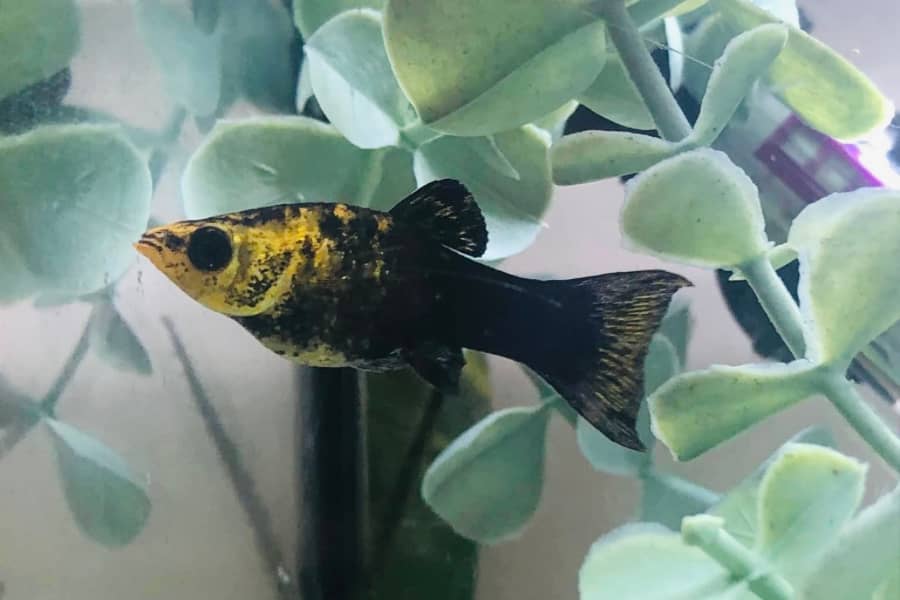
Mollies With White Stringy Poop
Ideally, healthy poop tends to be similar in color to the food being fed. So unless you have been feeding your fish something ‘white,’ the reason for white stringy feces can be constipation or internal parasites.
Since it’s not uncommon for a constipated fish to produce white stringy poop, before you consider chemical medications, put your fish on a fast for a day or two and feed boiled deshelled peas, preferably soaked in garlic juice.
If you don’t see any improvement in your Molly’s condition, the culprit is probably internal parasites. Try feeding metronidazole-medicated food to your fish.
White Spots (Ich) on Molly Fish
Ich or white spot disease is quite prevalent in Mollies. It’s caused by an external protozoan parasite that manifests as tiny white specks covering the fish’s fins, body, and gills. Ich is very easily noticeable on black Mollies.
Seachem Paraguard (available on Amazon) is an effective medication for treating Ich.
White Fluffy Stuff on Mollies
The white fuzzy patches are the telltale sign of fungal infection. It’s usually caused by poor water quality and stressful conditions.
As soon as you notice any sign of fungus, immediately quarantine the infected fish and start treating it with Melafix or Pimafix (or a combination of both), these medicines are available online store like Amazon.
Also, make sure you determine the underlying cause of the infection and eliminate it.
NOTE: Comlumnaris is a deadly disease that looks similar to the fungal outbreak. New fishkeepers can easily misdiagnose one for another.
Final Words
Keeping Mollies is arguably rewarding. They are fun and easy to take care of. Besides pristine quality water and a good diet, the Mollies aren’t demanding fish.
